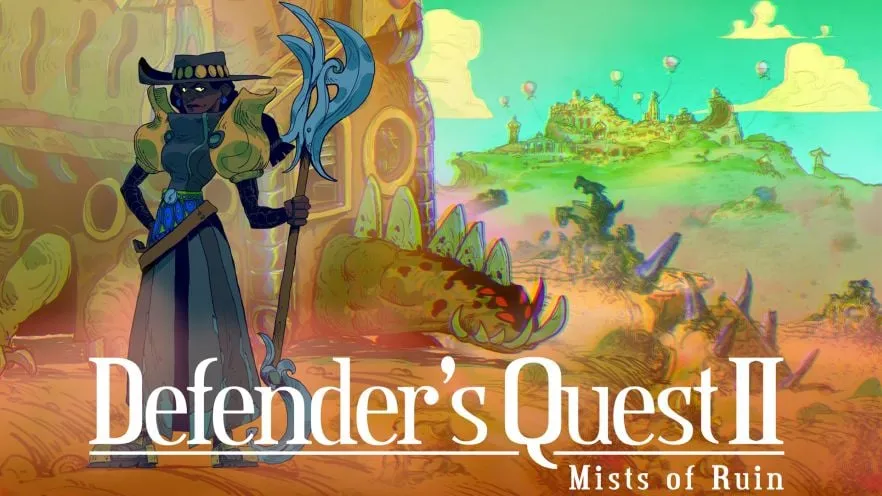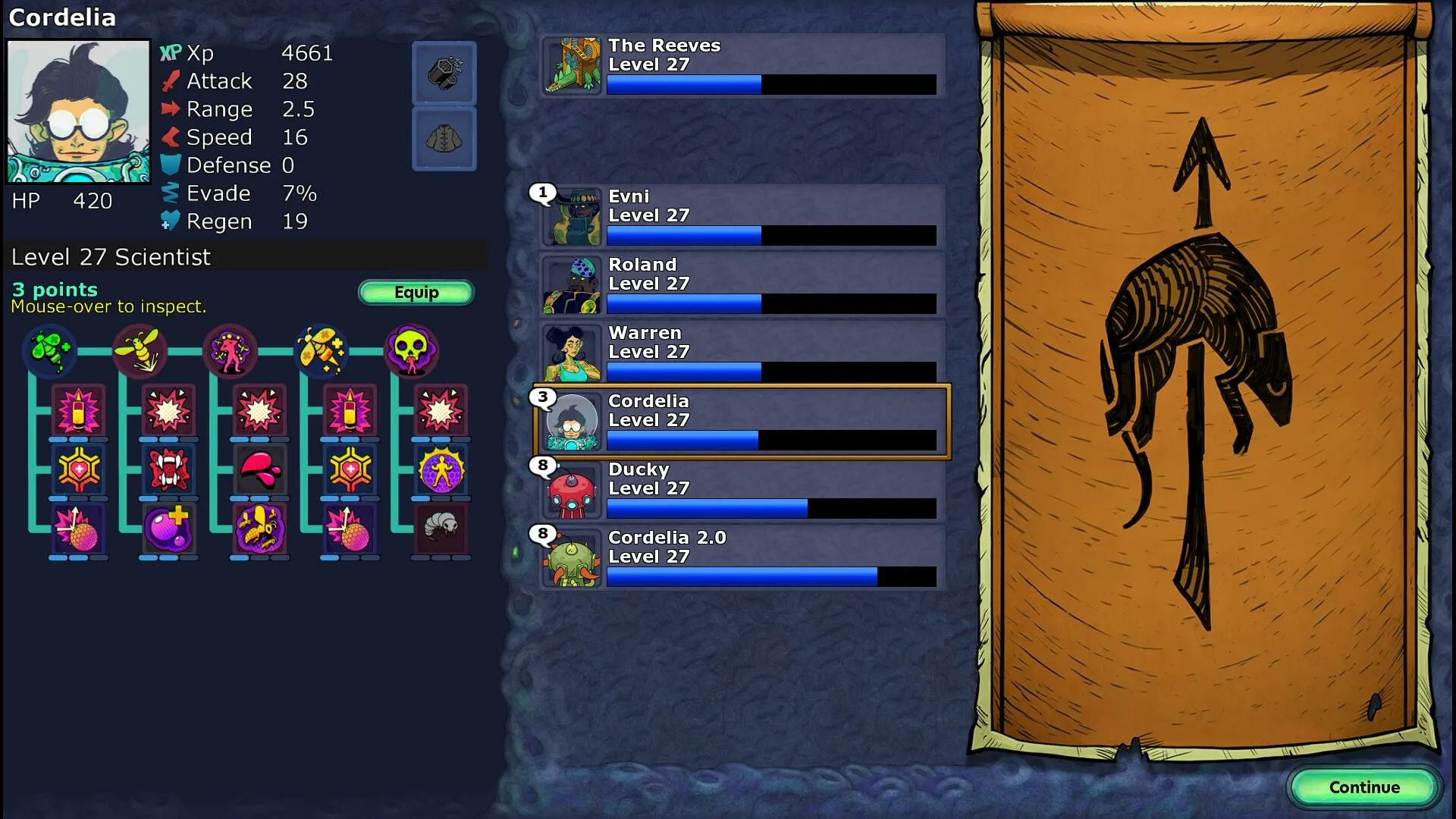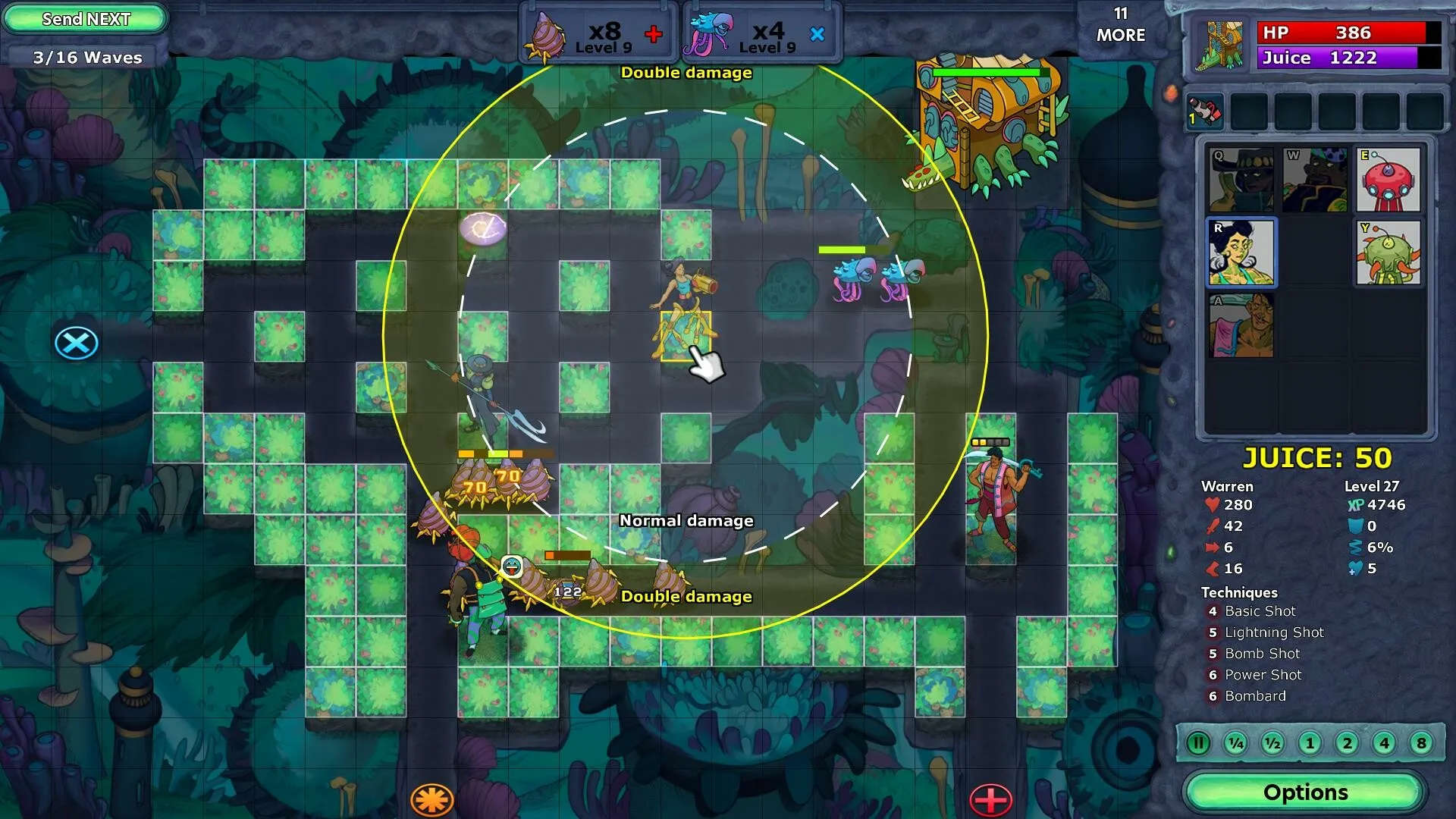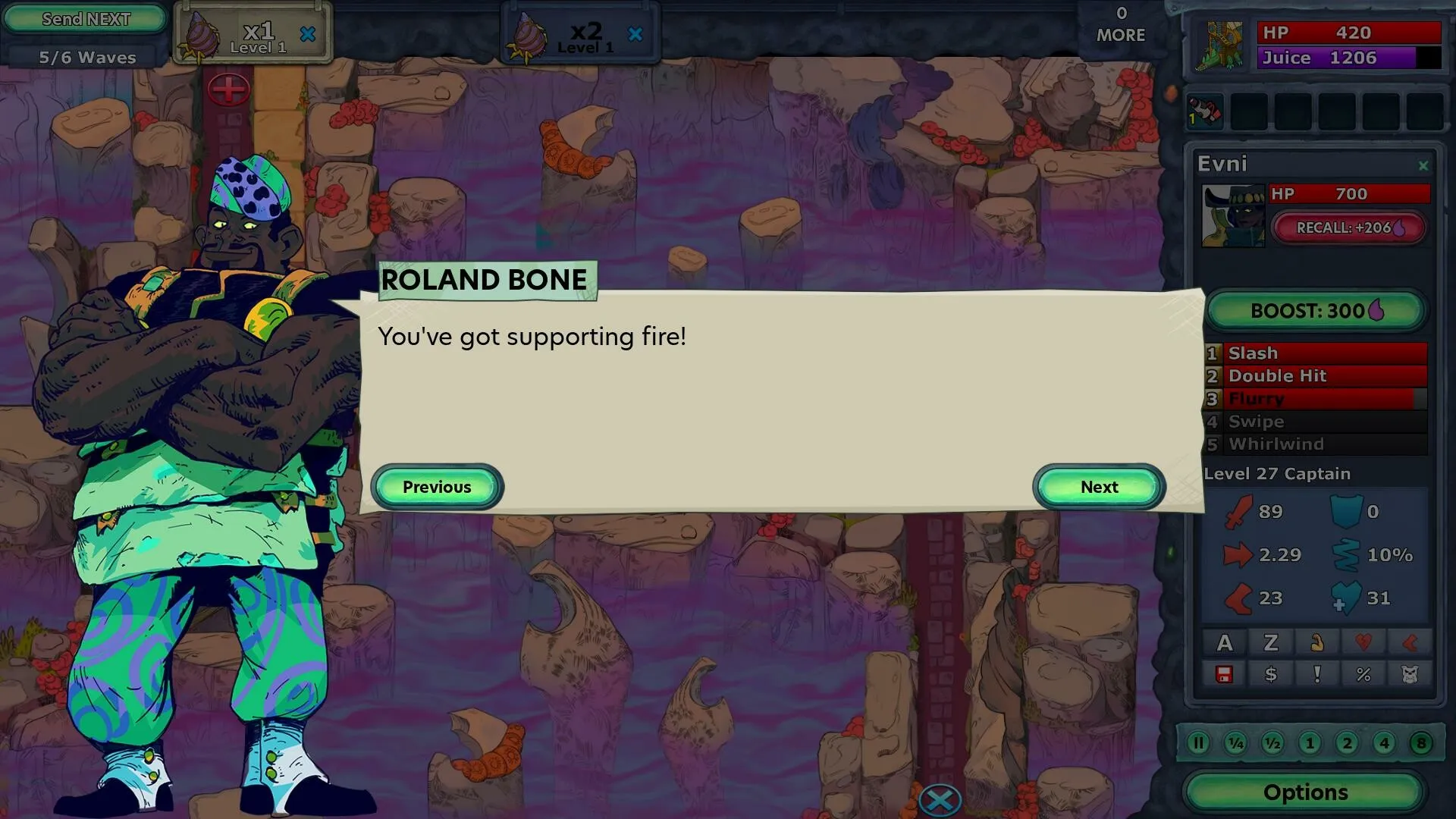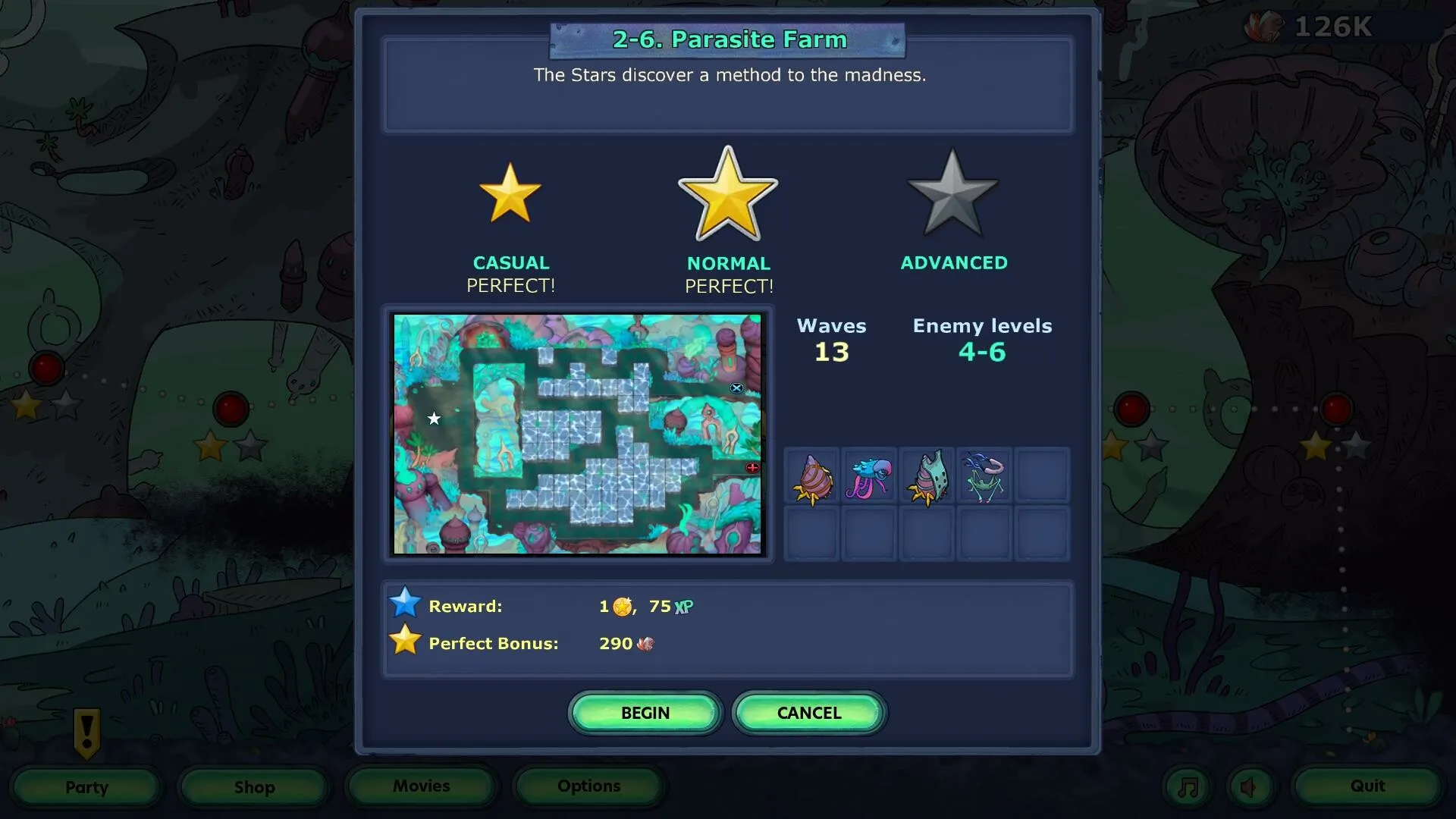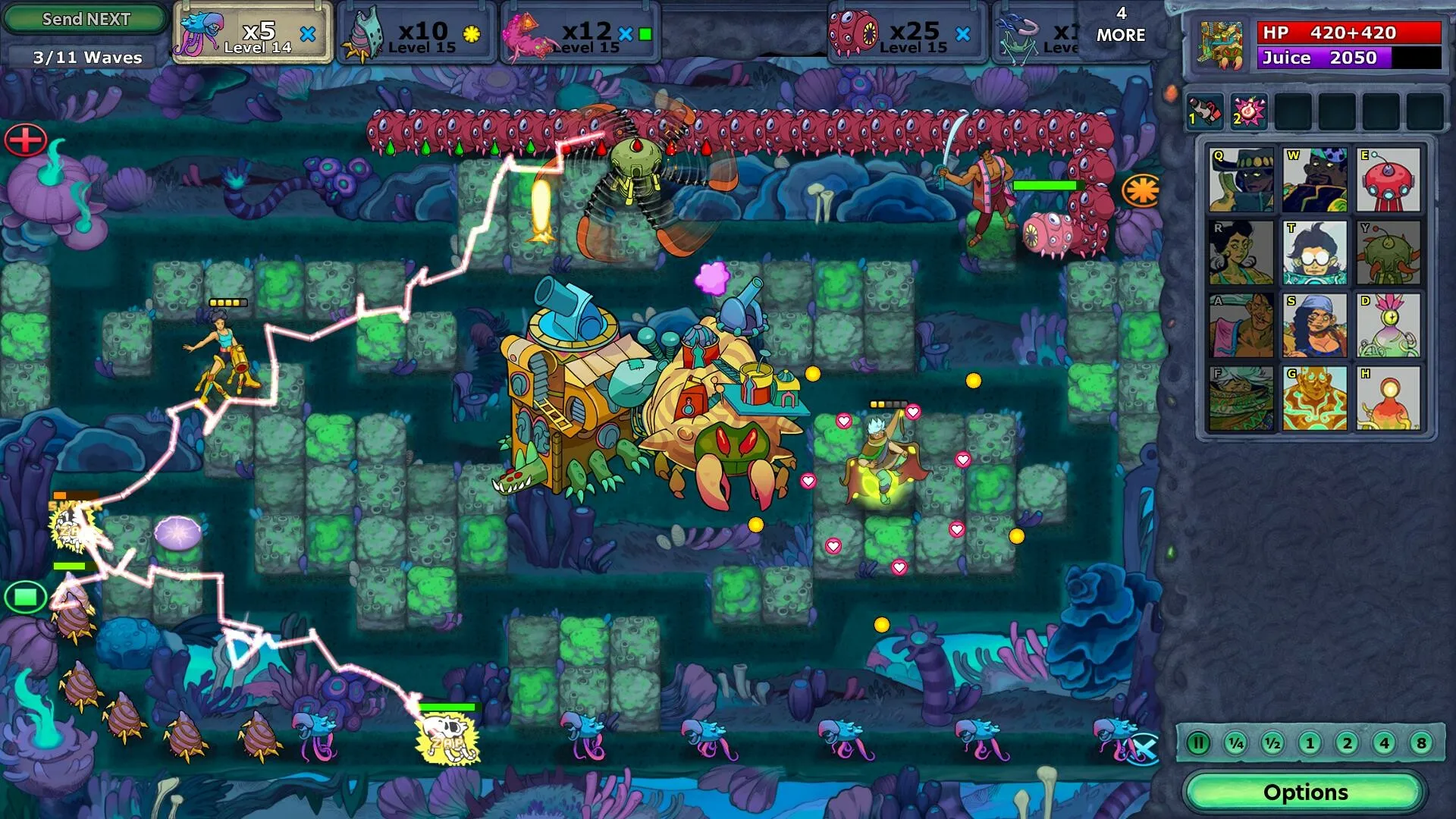Defender’s Quest 2: Mists of Ruin explores tower defense gameplay with strategic complexity. The gameplay centers on defending a base by positioning characters with specialized roles—including long-range attackers, protective units, and support characters—along a grid. Each character presents distinctive skills, and tactical placement critically impacts battle outcomes.
The game introduces a resource mechanic where defeated enemies drop “juice,” enabling players to enhance character capabilities during combat or activate ship-based actions. The ship functions as both an offensive and utility element, capable of damaging enemies or manipulating battlefield conditions through freezing or movement restrictions.
Character progression offers another engaging dimension. Players can develop characters by selecting skill upgrades, allowing customization of characters’ capabilities. This approach supports multiple tactical approaches based on individual character strengths and team composition.
Pausing combat to strategically reposition characters creates additional tactical opportunities. Thoughtful planning and creative character combinations enable players to develop powerful team dynamics, delivering an engaging experience within the tower defense game structure.
Story and Characters
Defender’s Quest 2: Mists of Ruin explores a world facing environmental destruction. The story centers on Evni Hunt, captain of the Reeves, a living transport ship, who confronts a crisis triggered by the Mirk—a threatening force generating dangerous creatures made of “juice.”
This catastrophe propels Evni and her crew to investigate and halt the menace spreading across the landscape. The narrative echoes post-apocalyptic settings like Against the Storm, where civilization’s survivors battle destructive natural forces, while introducing a distinct environmental disaster framework that highlights personal character experiences.
Character development stands as a key strength. Evni emerges as a complex protagonist, displaying a hardened exterior balanced with moments of emotional vulnerability. Her crew members create a dynamic group, offering humor and depth through their interactions.
Dialogue captures realistic exchanges, revealing character backgrounds and relationships through nuanced conversations. Small moments between characters provide insights into their connections, moving beyond typical quest-driven interactions.
Compared to the original Defender’s Quest, Mists of Ruin demonstrates significant character progression. The sequel explores deeper character personalities and interpersonal dynamics. Characters transcend typical tower defense roles, becoming fully realized individuals with personal motivations driving the narrative forward.
Visuals and Art Style
Defender’s Quest 2: Mists of Ruin transforms its visual approach with cel-shaded graphics, delivering a refined and engaging aesthetic. The new art style beautifully complements the game’s narrative and environmental storytelling.
Cel-shading creates an otherworldly atmosphere perfect for apocalyptic scenarios and strange creature encounters. Smooth, animated visuals capture an adventurous spirit while maintaining depth through strategic color and contrast choices.
Character design emerges as a standout visual element. Each crew member’s appearance reflects their personality and background. Evni’s angular features communicate her resolute nature, while other characters possess distinctive visual characteristics that help players quickly recognize them during gameplay. This attention to visual design supports the game’s character-driven storytelling, with visual traits closely aligned to narrative roles.
Environmental art supports the storytelling effectively. Diverse landscapes range from lush terrains to desolate regions ravaged by the Mirk. These visual settings create a rich atmospheric backdrop, establishing the world’s mood and supporting the characters’ journey. The art direction crafts a distinctive visual language that strengthens the game’s thematic exploration and immersive experience.
Sound and Music
Defender’s Quest 2: Mists of Ruin features a musical score that subtly supports the game’s narrative and emotional landscape. The soundtrack adapts to different gameplay moments, transitioning between mysterious exploration themes and energetic battle compositions.
Musical selections create an atmospheric experience that complements the game’s storytelling without dominating player attention. The sequel’s audio approach feels more refined compared to the original Defender’s Quest, matching the updated visual and narrative elements.
Sound effects contribute to player immersion. Combat sounds—weapon clashes and ship cannon explosions—create engaging audio feedback. Environmental audio elements generate a sense of a world experiencing turmoil, with background sounds that communicate the game’s apocalyptic setting.
Character voice performances, though limited in scope, enhance the written dialogue. Vocal performances inject personality into interactions, particularly during humorous exchanges, with a small but effective voice cast supporting the game’s narrative depth.
Controls and Usability
Defender’s Quest 2: Mists of Ruin provides responsive controls across PC and Steam Deck platforms. PC gameplay offers intuitive character selection and battlefield management with smooth keyboard and mouse interactions.
Command inputs feel natural, with well-organized key bindings supporting player actions. Steam Deck performance includes some touch control challenges, though the game remains playable. Future updates may address existing control limitations, supporting portable gaming experiences.
The game interface presents clear mission selection and menu navigation. Players can easily access character upgrades, skill trees, and inventory screens.
Game mechanics remain accessible through straightforward menu designs. Some players might perceive the menu visual style as less dynamic compared to the game’s artistic presentation, potentially creating slight visual disconnection.
Difficulty and Balance
Defender’s Quest 2: Mists of Ruin crafts a balanced gameplay experience that gradually increases challenge. Initial stages teach core mechanics of character placement, resource management, and upgrades.
Game difficulty escalates with more complex enemy types, demanding tactical adaptations. Enemy waves introduce varied challenges, including special abilities that disrupt player defenses. Players must constantly adjust strategies to overcome increasingly difficult encounters.
The game supports different player skill levels through flexible difficulty settings. Casual players can enjoy lower challenge modes, while experienced strategy enthusiasts can test their skills on harder levels. Tactical mechanics like time pausing and character repositioning allow deeper strategic planning.
Replayability stands out as a key feature. Multiple difficulty settings and optional challenge modes encourage players to revisit levels for improved rewards.
Experimental character builds and strategic approaches keep the experience engaging beyond the main campaign, appealing to tower defense game enthusiasts who enjoy strategic optimization.
Overall Experience and Replayability
Defender’s Quest 2: Mists of Ruin creates an engaging gameplay experience that captivates players through strategic depth and character progression. Carefully positioning characters and defending against enemy waves provides immediate satisfaction.
The game intertwines strategy, character growth, and resource management, generating a compelling cycle that motivates players to refine their approaches. Players experience continuous excitement through character upgrades and skill unlocking, maintaining gameplay excitement during extended sessions.
While the game follows established tower defense conventions, it delivers a refined experience with meaningful strategic elements.
Replayability emerges through multiple difficulty settings and challenge modes. Players can revisit earlier levels to optimize resources and improve performance. Character build customization and tactical experimentation encourage repeated gameplay.
Tower defense enthusiasts will find strategic complexity appealing, while new players can enjoy accessible mechanics and gradual difficulty progression. Strategic options and challenge variations ensure sustained player engagement.
The Review
Defender's Quest 2: Mists of Ruin
Defender’s Quest 2: Mists of Ruin refines the tower defense genre with engaging gameplay, a memorable cast, and rewarding tactical depth. While it may not reinvent the wheel, the game delivers an accessible and satisfying experience for both newcomers and genre veterans. Its strategic gameplay loop, enjoyable character progression, and solid replayability make it a standout in the genre, though it doesn’t push many boundaries. The updated art style and solid sound design complement the experience, offering a polished, enjoyable adventure.
PROS
- Engaging and accessible tower defense gameplay with strategic depth.
- Strong character development and interactions, enhancing the narrative.
- Polished, cel-shaded art style that fits the game’s tone.
- Solid replayability with multiple difficulty settings and challenge modes.
CONS
- Some UI elements feel mismatched with the game’s vibrant art style.
- Limited voice acting, which could have enhanced the character-driven story.








































